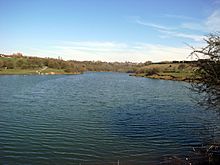Fens Pools facts for kids
| Site of Special Scientific Interest | |

Middle Pool
|
|
| Area of Search | West Midlands |
|---|---|
| Interest | Biological |
| Area | 37.6 hectares |
| Notification | 1989 |
| Location map | English Nature |
Fens Pools is a special natural area in the West Midlands. It covers about 37.6 hectares, which is like 93 football fields! This place is so important for nature that it was named a "Site of Special Scientific Interest" (SSSI) in 1989. This means it's protected by law because of its amazing wildlife. The Country Trust helps look after it today.
Contents
The History of Fens Pools
The Fens Pools area has three main pools: Grove Pool, Middle Pool, and Fens Pool. These pools were built a long time ago by the Stourbridge Canal Company. The canal itself opened in 1779.
The pools were created to hold water for the canal. This water was very important for the canal's "locks." Locks are like water elevators that help boats move up and down hills. The Stourbridge Canal had 16 locks that lowered the water level by 145 feet (about 44 meters)! The pools were the main way to keep these locks full of water. Later, in 1792, water from the Dudley Canal also helped supply the Stourbridge Canal.
Where to Find Fens Pools
Fens Pools is located in the Metropolitan Borough of Dudley. You can find it between the towns of Pensnett and Brierley Hill. It is also part of a bigger natural area called the Buckpool and Fens Pool Local Nature Reserve.
Wildlife at Fens Pools
Fens Pools is a fantastic place for many different kinds of plants and animals. It has open water, marshy areas, wet grasslands, and even some scrubland. This mix of habitats makes it perfect for lots of wildlife.
Amphibians and Their Reproduction
This site is known as the best place in the West Midlands for amphibians. Amphibians are creatures like frogs, toads, and newts that can live both in water and on land.
- You can find common frogs and common toads here.
- There are also smooth newts.
- Most importantly, Fens Pools has the largest group of great crested newts in the entire West Midlands. These newts are very special and need clean water to breed.
Amazing Plants
The area is home to many interesting plants, including different kinds of grasses and sedges.
- Look out for mare’s-tail, which grows in the water.
- You might also spot common club-rush and orange foxtail.
- Another plant found here is lesser water-parsnip.
- Some parts of the grassland show old farming patterns called "ridge and furrow." Here, you can find a rare plant called adder’s-tongue fern.
Insects of the Pools
Fens Pools is buzzing with insect life!
- At least ten different kinds of dragonfly have been seen flying around the pools.
- More than twenty different kinds of butterfly also live here, adding bright colors to the landscape.
Birds of Fens Pools
The pools and surrounding areas are important for many birds, both those that live here all year and those that visit.
- Birds that build their nests and raise their young here include the reed warbler, the sedge warbler, and the lesser whitethroat.
- The elegant great crested grebe also breeds on the open water.
- Sometimes, you might even see the little ringed plover, a small wading bird.
The large open water areas are very important for birds that spend the winter here or are just passing through on their long journeys.

